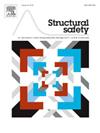Comparison of probabilistic structural reliability methods for ultimate limit state assessment of wind turbines
Abstract
The probabilistic design of offshore wind turbines aims to ensure structural safety in a cost-effective way. This involves conducting structural reliability assessments for different design options and considering different structural responses. There are several structural reliability methods, and this paper will apply and compare different approaches in some simplified case studies. In particular, the well known environmental contour method will be compared to a more novel approach based on sequential sampling and Gaussian processes regression for an ultimate limit state case study on the maximum flapwise blade root bending moment. For one of the case studies, results will also be compared to results from a brute force simulation approach. Interestingly, the comparison is very different from the two case studies. In one of the cases the environmental contours method agrees well with the sequential sampling method but in the other, results vary considerably. Probably, this can be explained by the violation of some of the assumptions associated with the environmental contour approach, i.e. that the short-term variability of the response is large compared to the long-term variability of the environmental conditions. Results from this simple comparison study suggests that the sequential sampling method can be a robust and computationally effective approach for structural reliability assessment.

 求助内容:
求助内容: 应助结果提醒方式:
应助结果提醒方式:


